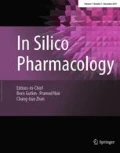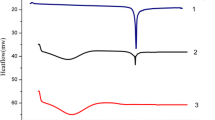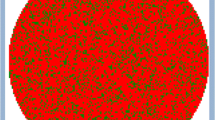Abstract
In this study, the release characteristics of gliclazide in a polymeric matrix system, which is used for controlled drug release purposes, are conducted experimentally and numerically. A code using the finite element method predicting the drug release behavior of gliclazide matrix system in an aqueous medium is developed. The parameters having significant importance in drug release kinetics, such as structure factor, the slab’s size and shape are varied systematically. The consistent reduction in the solid drug during the dissolution process is evaluated. The numerical data agree well with the experimental results. Therefore, the controlled drug release of gliclazide is accurately modeled by the present numerical code. The results imply that the porosity of the matrix system has the most significant effect on the drug dissolution rate. The reduction in the tablet’s diameter and utilization of cylindrical slab geometry increases the speed of the drug dissolution in the aqueous medium.







Similar content being viewed by others
Data availability
The data that support the findings of this study are available from the corresponding author upon reasonable request.
References
Ambrogi V, Perioli L, Ciarnelli V, Nocchetti M, Rossi C (2009) Effect of gliclazide immobilization into layered double hydroxide on drug release. Eur J Pharm Biopharm [Internet] 73(2):285–291
Bajpai S, Chand N, Soni S (2015) Controlled release of anti-diabetic drug gliclazide from poly(ca prolactone)/poly(acrylic acid) hydrogels. J Biomater Sci Polym Ed 26:947–962
Barba AA, d’Amore M, Chirico S, Lamberti G, Titomanlio G (2009) A general code to predict the drug release kinetics from different shaped matrices. Eur J Pharm Sci [Internet] 36(2):359–368
Bettini R, Colombo P, Massimo G, Catellani PL, Vitali T (1994) Swelling and drug release in hydrogel matrices: polymer viscosity and matrix porosity effects. Eur J Pharm Sci [Internet] 2(3):213–219
Blagoeva R, Nedev A (2008) A problem for drug release from 2D polymeric systems. Mech Res Commun [Internet] 35(5):344–349
Borgquist P, Körner A, Piculell L, Larsson A, Axelsson A (2006) A model for the drug release from a polymer matrix tablet-effects of swelling and dissolution. J Control Release 113:216–225
Choi J, Konno T, Takai M, Ishihara K (2009) Controlled drug release from multilayered phospholipid polymer hydrogel on titanium alloy surface. Biomaterials [Internet] 30(28):5201–5208
Cobby J, Mayersohn M, Walker GC (1974) Influence of shape factors on kinetics of drug release from matrix tablets I: theoretical. J Pharm Sci [Internet]. 63(5):725–732
Cussler EL (2009 Diffusion-mass transfer in fluid systems, 3rd edn. Textbook part of Cambridge series in chemical engineering. University of Minnesota. ISBN: 9780521871211. https://www.cambridge.org/tr/academic/subjects/engineering/chemical-engineering/diffusion-mass-transfer-fluid-systems-3rd-edition?format=HB&isbn=9780521871211
Frenning G, Strømme M (2003) Drug release modeled by dissolution, diffusion, and immobilization. Int J Pharm [Internet] 250(1):137–145
Frenning G, Fichtner F, Alderborn G (2005) A new method for characterizing the release of drugs from single agglomerates. Chem Eng Sci [Internet] 60(14):3909–3918
Higuchi T (1963) Mechanism of sustained-action medication. Theoretical analysis of rate of release of solid drugs dispersed in solid matrices. J Pharm Sci [Internet] 52(12):1145–1149. https://doi.org/10.1002/jps.2600521210
Jaimini M, Kothari A (2012) Sustained release matrix type drug delivery system: a review. J Drug Deliv Ther. https://doi.org/10.22270/jddt.v2i6.340
Kuentz M, Holm R, Elder DP (2016) Methodology of oral formulation selection in the pharmaceutical industry. Eur J Pharm Sci 87:136–163
Lamberti G, Galdi I, Barba AA (2011) Controlled release from hydrogel-based solid matrices. A model accounting for water up-take, swelling and erosion. Int J Pharm [Internet]. 407(1):78–86
Lee AJ, King JR, Hibberd S (1998) Mathematical modelling of the release of drug from porous, nonswelling transdermal drug-delivery devices. Math Med Biol AJIMA [Internet] 15(2):135–163. https://doi.org/10.1093/imammb/15.2.135
Lemaire V, Bélair J, Hildgen P (2003) Structural modeling of drug release from biodegradable porous matrices based on a combined diffusion/erosion process. Int J Pharm [Internet] 258(1):95–107
Lu M, Xing H, Yang Z, Sun Y, Yang T, Zhao X et al (2017) Recent advances on extracellular vesicles in therapeutic delivery: challenges, solutions, and opportunities. Eur J Pharm Biopharm 119:381–395
Patel H, Panchal DR, Patel U, Brahmbhatt T, Suthar M (2011) Matrix type drug delivery system: a review. J Pharm Sci Biosci Res 1:143–151
Pisani L (2011) Simple expression for the tortuosity of porous media. Transp Porous Media [Internet]. 88(2):193–203. https://doi.org/10.1007/s11242-011-9734-9
Pitt CG, Schindler A (1995) The kinetics of drug cleavage and release from matrices containing covalent polymer-drug conjugates. J Control Release [Internet] 33(3):391–395
Reddy KR, Mutalik S, Reddy S (2003) Once-daily sustained-release matrix tablets of nicorandil: formulation and in vitro evaluation. AAPS PharmSciTech [Internet]. 4(4):480–488. https://doi.org/10.1208/pt040461
Siepmann J, Kranz H, Bodmeier R, Peppas NA (1999) HPMC-matrices for controlled drug delivery: a new model combining diffusion, swelling, and dissolution mechanisms and predicting the release kinetics. Pharm Res [Internet] 16(11):1748–1756. https://doi.org/10.1023/A:1018914301328
Tan H, Xing S, Bi X, Li L, Gong H, Zhong M et al (2008) Felodipine attenuates vascular inflammation in a fructose-induced rat model of metabolic syndrome via the inhibition of NF-κB activation. Acta Pharmacol Sin [Internet] 29:1051. https://doi.org/10.1111/j.1745-7254.2008.00843.x
Thombre AG, am Ende MT, Wu XY (2010) Controlled release technology and design of oral controlled release dosage forms [Internet]. Chem Eng Pharm Ind. https://doi.org/10.1002/9780470882221.ch37
Acknowledgements
This work is supported by Cukurova University Scientific Research Office financially under contract no FBA-2017-7960 and FBA-2019-12419.
Author information
Authors and Affiliations
Corresponding author
Ethics declarations
Conflict of interest
The authors declare no conflict of interest.
Additional information
Publisher's Note
Springer Nature remains neutral with regard to jurisdictional claims in published maps and institutional affiliations.
Rights and permissions
About this article
Cite this article
Tatlisoz, M.M., Demirturk, E. & Canpolat, C. Release characteristics of gliclazide in a matrix system. In Silico Pharmacol. 9, 12 (2021). https://doi.org/10.1007/s40203-020-00068-5
Received:
Accepted:
Published:
DOI: https://doi.org/10.1007/s40203-020-00068-5




